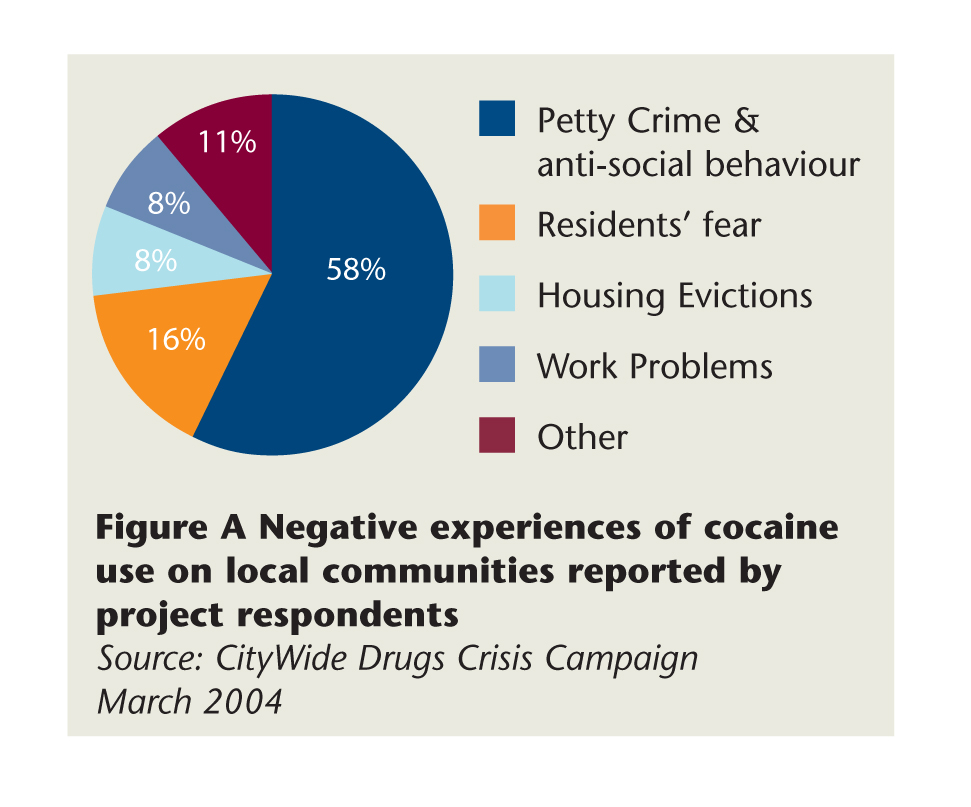Kelly, Fionnola (2004) CityWide Drugs Crisis Campaign. Drugnet Ireland, Issue 11, June 2004, p. 5.
| Preview | Title | Contact |
|---|---|---|
|
PDF (Drugnet Ireland, issue 11)
- Published Version
342kB |
In March 2004, CityWide Drugs Crisis Campaign published a report entitled Cocaine in local communities: survey of community drug projects.1 This survey was carried out in response to the growing concern expressed by community groups across Dublin in relation to the emerging cocaine problem in many parts of the city1. The authors surveyed community drug projects to establish whether cocaine users were being treated by local services and, if so, what services were offered to them and what additional services needed to be developed.
Questionnaires were sent to 59 community drug projects requesting information about cocaine use among clients of services and within communities. Although the response rate was low (46 per cent), the projects that participated in the study represented each task force area within Greater Dublin and that of Dun Laoghaire–Rathdown. The non-respondents may manage drug projects where cocaine use is not a problem, and therefore did not complete the questionnaire, leading to a reporting bias.
Twenty-five (93 per cent) of the 27 respondents claimed that some existing clients were using cocaine. Three-quarters of the project participants estimated that between 10 and 50 per cent of their clients were using cocaine. However, it is unclear from the report whether or not this cocaine use was problematic. All of the project workers who took part in the study said that they were aware of people living in their communities who were using cocaine but not currently seeking treatment at their services. Fifty-eight per cent of the project workers noted that cocaine use was on the increase among young people. Almost one-third of the respondents claimed that cocaine was cheap and easily available, while one in four could identify where cocaine was being sold. Two project participants noted that there was a significant difference in the price of cocaine being sold in different parts of their communities. Three stated that heroin supplies were decreasing in their areas while cocaine was on the increase. One-fifth of the respondents viewed cocaine as a social drug that was being used by people who had not used drugs in the past.
The report outlines the implications cocaine has for the users and their families and for the wider community.
Individuals
- Fifty-two per cent of the project workers reported that cocaine use caused clients to become aggressive and agitated, resulting in difficulties for staff.
- Almost two-fifths of the respondents reported that the ‘high’ from cocaine does not last very long; clients therefore use cocaine more frequently, which has cost implications.
- Fifteen per cent of project workers reported that clients were becoming involved in crime in order to cover the costs of their cocaine use.
- Twenty-two per cent of the participants reported that clients presented with mental health problems.
- A number of project workers, particularly those in the south inner city and Ballyfermot, reported that clients injecting cocaine combined with heroin were developing deep vein thrombosis (DVT) and abscesses.
Families
- Almost half of the participants stated that cocaine was responsible for domestic rows.
- Thirty per cent claimed that parents of cocaine users were extremely worried and unsure of how to deal with the problem.
- Project respondents in Dublin 8 claimed that families had no option but to leave the area because of cocaine-related debt or anti-social behaviour.
- Some project workers reported an increase in the number of young people forced to leave home because of their cocaine use.
- Respondents reported that cocaine can also have a negative impact on the children of users; for example, in the Dublin 8 area a small number of children had been put into care because of their parents’ excessive cocaine use.
Communities (Figure A)
- Fifty-eight per cent of project workers reported increases in petty crime, dealing and other anti-social behaviour within their community,
- Eight per cent of project staff cited recreational cocaine use as causing work-related problems for a number of people living in the area.

The lack of services available to cocaine users was of particular concern to those who participated in the study. According to the report, almost one in five respondents said that they had no services for cocaine users; however, the majority of projects did provide some services. These included: acupuncture, yoga, reiki, relaxation methods, Indian massage, and home detoxification through acupuncture and acupressure. Almost 60 per cent of the projects provided counselling, while 45 per cent provided harm reduction services specifically for cocaine users. Fourteen per cent provided practical support, such as laundry, bathing facilities and nursing care. Half of the project workers claimed that they were not aware of any other service available to treat cocaine use in their area. Project workers stated that they would be interested in providing:
- Alternative therapies specifically for cocaine users;
- Cocaine-specific education programmes;
- Respite for cocaine users;
- Detoxification programmes.
However, in order for such services to be developed, project workers felt that they would need additional training and an increase in staffing and funding, and evidence of political will to tackle the issue. The findings of this study support the findings reported by the National Advisory Committee on Drugs in its overview of cocaine use in Ireland.2
References
1. CityWide Drugs Crisis Campaign (2004) Cocaine in local communities: survey of community drug projects. Dublin: CityWide Drugs Crisis Campaign.
2. National Advisory Committee on Drugs (2003) An overview of cocaine use in Ireland. Dublin: The Stationery Office.
Repository Staff Only: item control page